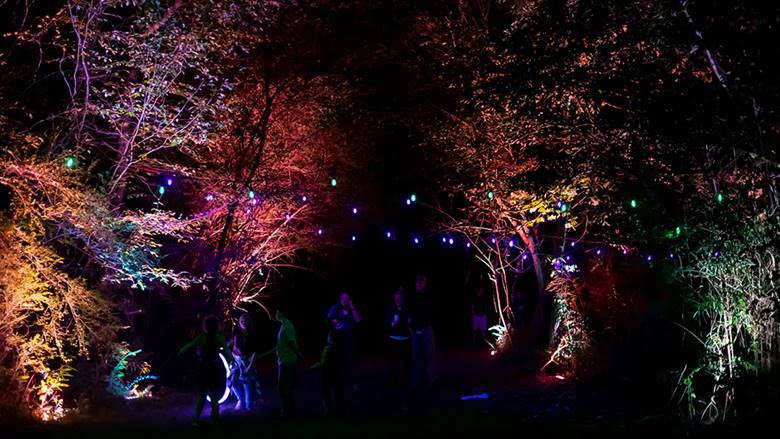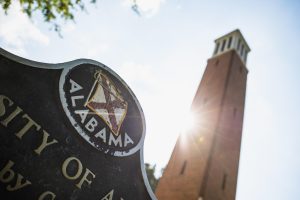Flow Tuscaloosa inspires environmental stewardship through visual art project
June 1, 2022
With engaging visual art projects that culminated in a lantern parade on Saturday, May 21, Flow Tuscaloosa is working to foster environmental stewardship among The University of Alabama and the greater Tuscaloosa community, specifically for the Black Warrior River and its tributaries.
The project began after conversations between the UA Collaborative Arts Research Initiative fellows, Jamey Grimes, an assistant professor of art, sculpture and museum studies, and Julia Brock, an assistant professor of history. The project is also a collaboration with Selvage, a curatorial collective, UA museums, and the Friends of Hurricane Creek.
Upon meeting, Grimes and Brock found that despite their different backgrounds in curatorial practice, they had a common interest in the local landscape, environmental justice, awareness and stewardship.
“We have a vision of how this will be very beautiful and amazing, but a part of our vision is having a lot of people make that happen by just being themselves,” Grimes said.
Grimes said that with Flow Tuscaloosa, they wanted to encourage people to become involved in conversations of stewardship and to understand their community’s relationship to waterways.
While thinking of stewardship and the kinds of natural resources they wanted to promote the preservation of, Grimes and Brock started conversations with the Friends of Hurricane Creek, an organization dedicated to the health, restoration and overall wellbeing of Hurricane Creek. This Tuscaloosa County creek has suffered from coal-mining pollution, overdevelopment, poor building code enforcement and the overuse of herbicides.
Grimes said Hurricane Creek was a striking example of a somewhat positive story and has been the “spotlight focus” for this round of Flow Tuscaloosa. Since its founding in the 1990s, Friends of the Hurricane Creek, with help from the Citizens Coal Council and Alabama Environmental Council, has seen dramatic improvements to the tributary and local wildlife.
However, as Grimes and Brock began to develop broader concepts for incorporating a public audience into their activities, they realized that it would be easier to navigate public access along the Riverwalk. So, Flow Tuscaloosa focused on the Black Warrior River.
Along with ideas of environmental stewardship, justice and awareness, the two coincidentally had an interest in doing a lighting event, which evolved into the parade on May 21.
Grimes said he had created different smaller-scale outdoor lighting experiments that were designed to bring the community together in the past, so they played off those ideas for the parade.
“I’ve seen the power of beautiful lighting in the natural environment as a way to create an elevated experience,” he said. “So rather than trying to create something that’s synthetic in the natural world, the real idea there is that by lighting something in the evening, you start to see in a different way what you’re already looking at on a regular basis.”
Flow Tuscaloosa hosted lantern-making workshops at every First Friday event at the Tuscaloosa Art Walk to prepare for the parade in March.
At the Dinah Washington Cultural Arts Center, patrons perused the art exhibitions that sat in the other sections of the center before discovering Flow Tuscaloosa’s station. Around tables covered in arts and crafts materials, Grimes, Brock and volunteers informed people about Flow Tuscaloosa and their goals while helping them create unique paper lanterns out of thin sheets of tissue paper, small wooden sticks, tape and wire.
Grimes said they tried to make sure the lanterns could be disposed of easily “if they reached the end of their life cycle at the end of the parade.”
While constructing their lanterns, people were free to create vibrant and unique designs and patterns with various materials that resembled organisms from the Black Warrior River’s ecosystem.
Grimes said that though the lantern construction is “pretty basic,” it’s a way to actively learn about the images people put on their lanterns, like dragonflies or historic structures, through the community’s participation and commitment to understanding.
“And so that physical process of building a lantern. It also kind of locks in a lot of what we want to accomplish because we’re bombarded by facts. We’re bombarded by images on a regular basis and so we’re looking for an experience that can slow that process down, and hopefully, again, elevate the learning the experience and the participation for from our community when they join us,” Grimes said.
The parade began at 7 p.m. on Saturday at the entrance to the Riverwalk.
“We’ll wait for the sky to darken a bit before we start the procession at 7:30,” Brock said in a press release. “If you came to a workshop and would like to use one of our lights, arriving at 7 will ensure we have time to fit your lantern with a light.”
The parade ended at the River Market before crossing the street to the Mildred Westervelt Warner Transportation Museum.
After the parade, people hung their lanterns and gathered in the “reanimated” Queen City Pool for “An Evening at the Pool.” The Pool is filled in on the Transportation Museum’s grounds, and the Swimming Together exhibit inspires the event. There, people enjoyed food trucks, music and a light installation by Lyndell McDonald, a UA assistant professor and technical supervisor.
“There will just be time to kind of really convene and commune with each other and local river keepers and other kinds of folks that have a stake in the waterways,” Brock said.





















